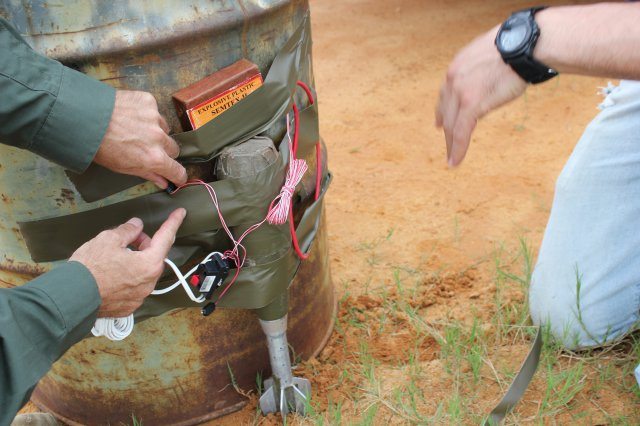The U.S. Army Forces Command Counter-IED Integration Cell recently developed and implemented training packages to complement the upcoming Joint Operational Access Exercise held here, Sept. 14-20.
Counter-IED, referred to as C-IED, training is a command priority, and is included in U.S. Army Forces Command, known as FORSCOM, regulation 350-1. The training fulfills all pre-deployment requirements; ensuring units are capable of conducting operations in IED environments.
The training scenario was part of the Joint Operational Access Exercise, or JOAX — a combined joint-training exercise designed to prepare elements of the 82nd Airborne Division; utilizing the Air Force, along with its coalition partners, to respond to worldwide crises and contingencies as part of the Global Response Force. The Fort Bragg Counter-IED Integration Cell, or CI2C, trained 82nd Airborne personnel in IED awareness, identification, hazard, and avoidance.
Soldiers participating included the 3rd Brigade Combat Team, 82nd Airborne Division, and Airmen from the U.S. Air Force as well as Italian Paratroopers from the 187th Regiment of the Folegore Brigade (Airborne).
The exercise consisted of multiple nighttime combat equipment jumps onto the Holland Drop Zone, assaulting and clearing a flight landing strip, clearance of an eight building compound with an aircraft hangar, an air assault, a ground assault convoy, and the evacuation of civilian noncombatants.
Training IEDs were placed in several strategic locations as part of the overall operation. After the airfield seizure, Soldiers identified and cleared an IED emplaced near the Forward Landing Strip, before moving onto clearing any opposition from the nearby buildings. A vehicle borne-IED obstacle needing to be identified and cleared, was emplaced in the hangar area.
Throughout the remainder of the three-day exercise, additional IEDs were emplaced using the same techniques, tactics, and procedures that are being utilized by various potential enemy combatants that the 82nd Airborne Division may encounter as part of the Global Response Force. The addition of IEDs into the training scenario ensures that the Soldiers remain highly trained on a global IED threat, not a specific country or area.
“The IEDs are not meant to be the mission, but as part of the overall operation simulating real-world conditions,” said Col. Curtis A. Buzzard, commander, 3rd Brigade Combat Team, 82nd Airborne Division.
The FORSCOM C-IED strategy provides a framework for the Army to anticipate, adapt and respond to the IED threat so that Soldiers receive timely, effective C-IED solutions that enable them to perform their missions with confidence and reduced risk. It is designed to assist FORSCOM units at brigade and below to plan for and apply the entire spectrum of C-IED training resources at home station as part of a holistic C-IED training plan for the operational force.
“Each Home Station CI2C provides our armed forces with pre-deployment C-IED training, preparing them for their road-to-war. Expertise is provided in both the classroom and field environments, such as the Joint Operational Exercise. As a result, the 3rd Brigade solicited input from the Fort Bragg CI2C to design and implement this particular training scenario to compliment the overall exercise,” said John Coomer, Fort Bragg CI2C training integrator.
Prepared with this knowledge, Army units can learn to identify and focus their training on the IED threats they will face in their area of operations.
The IED is an enduring and challenging threat, especially when employed by groups who are adaptive and innovative, constantly adjusting their methods to achieve their desired effects. The Army must be equally agile, initially matching, and then quickly outpacing an adversary’s ability to adapt to U.S. operations.
Implementation of this strategy ensures that combatant commanders receive trained and disciplined Army units that are well equipped to operate in an IED environment and leaders and Soldiers who are confident of their ability to cope with the IED threat as part of unified land operations.
After 13 years of combat deployments, the JOAX, which is scheduled three times a year, ensures each rotation of personnel are proficient and trained, and resets the readiness cycle.











